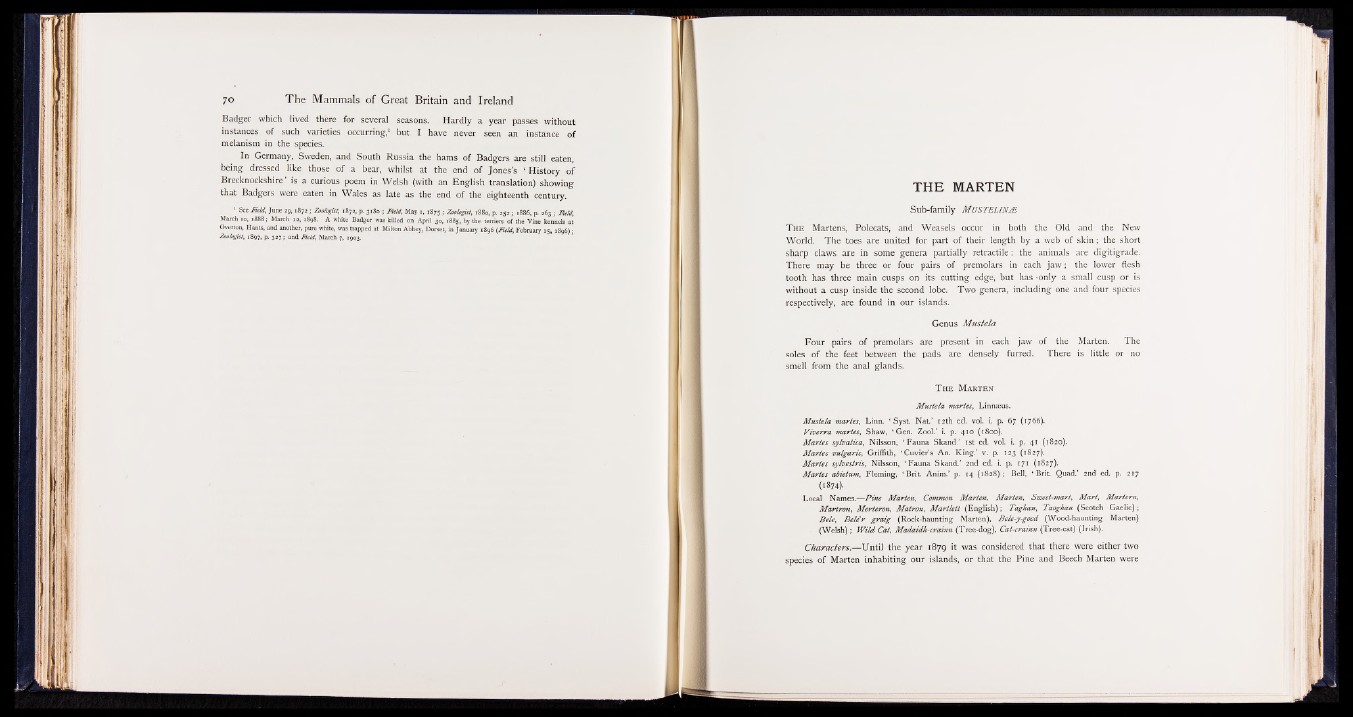
Badger which lived there for several seasons. Hardly a year passes without
instances of such varieties occurring,1 but I have never seen an instance of
melanism in the species.
In Germany, Sweden, and South Russia the hams of Badgers are still eaten,
being dressed like those of a bear, whilst at the end of Jones’s ‘ History of
Brecknockshire is a curious poem in Welsh (with an English translation) showing
that Badgers were eaten in Wales as late as the end of the eighteenth century.
1 See Meld, June 29,1872; Zoologist', 1872, p. 3180 ; Meld, May 1, 1875 ; Zoologist, 1880, p. 252; 1886, p. 263; Meld,
March 10, 1888; March 12, 1898. A white Badger was killed on April 30, 1885, by the terriers of the Vine kennels at
Overton, Hants, and another, pure white, was trapped at Milton Abbey, Dorset, in January 1896 (Field, February 15, 1896) ;
Zoologist, 1897, p. 327; and Field, March 7, 1903.
THE MARTEN
Sub-family MUSTELINE
T he Martens, Polecats, and Weasels occur in both the Old and the New
World. The toes are united for part of their length by a web of skin; the short
sharp claws are in some genera partially retractile: the animals are digitigrade.
There may be three or four pairs of premolars in each jaw ; the lower flesh
tooth has three main cusps on its cutting edge, but has «only a small cusp or is
without a cusp inside the second lobe. Two genera, including one and four species
respectively, are found in our islands.
Genus Mustela
Four pairs of premolars are present in each jaw of the Marten. The
soles of the feet between the pads are densely furred. There is little or no
smell from the anal glands.
T h e M a r t e n
Mustela martes, Linnaeus.
Mustela martes, Linn. * Syst Nat.’ 12th ed. vol. i. p. 67 (1766).
Viverra martes, Shaw, ‘Gen. Zool.’ i. p. 410 (1800).
Martes sylvatica, Nilsson, ‘ Fauna Skand.’ 1st ed. vol. i. p. 41 (1820).
Martes vulgaris, Griffith, ‘ Cuvier’s An. King.’ v. p. 123 (1827).
Martes sylvestris, Nilsson, ‘ Fauna Skand.’ 2nd ed. i. p. 171 (1827).
Martes abietum, Fleming, ‘ Brit Anim.’ p. 14 (1828); Bell, ‘ BriL Quad.’ 2nd ed. p. 217
(1874).
Local Names.—Pine Marten, Common Marten, Marten, Sweet-mart, Mart, Mortem,
Martron, Merteron, Matron, Martlett (English); Tagkan, Taoghan (Scotch Gaelic);
Bele, Bele'r graig (Rock-haunting Marten), Bele-y-goed (Wood-haunting Marten)
(Welsh) ; Wild Cat, Madaidh-crainn (Tree-dog), Cat-crainn (Tree-cat) (Irish).
Characters.—Until the year 1879 it was considered that there were either two
species of Marten inhabiting our islands, or that the Pine and Beech Marten were